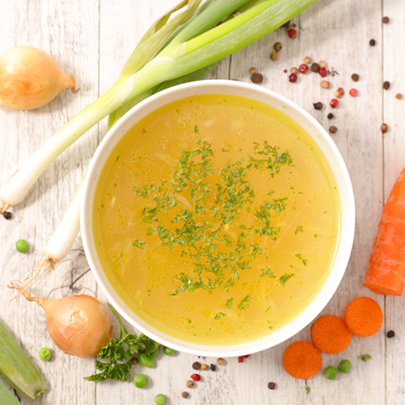I could honestly write an ode to this broth (update – I did, for Insta, whilst it bought some light to the world, Shakespeare I’m not😂).
This broth has a place in EVERY home and I reckon has to be one of my most used recipes.
Why? Cause it’s so versatile and super quick hands-on time.
I love versatile recipes cause when you make them regularly you get to go on auto-pilot which reduces overwhelm and simplifies herbal medicine-making in your busy life!
Today we’ll talk about my immunity broth version – and some of the herbs you might want to include. At the end I’ll talk about how I like to use this broth
Benefits of herbal immunity broth
The benefits will depend on which herbs you use, but some herbs I always like to include:
Astragalus (Astragalus membranaceus) Astragalus has an affinity for the immune system and is an immunomodulator herb, meaning it brings the immune system into balance – whether it’s under or over-functioning (learn to decode herbal jargon around immunity in this article (click here).
I was taught that Chinese grandma’s would start adding Astragalus to the stock pot in autumn, to build immunity ahead of the winter cold and flu season. And that’s what I do too. It doesn’t stimulate the immune system acutely, but it works as a deep immune tonic, improving immune function when used over time.
But it’s not just for prevention – astragalus is also a deeply supportive herb to use after illness. It’ll help you recover more fully so you don’t go down the route of recurrent infections.
NOTE – In Traditional Chinese Medicine, astragalus is contraindicated when you’re acutely sick.
Shiitake (lentinula edodes)– another immune superstar, shiitake is both an immunomodulator herb with antiviral and antimicrobial actions. See this article for more info (click here)
Seaweeds: seaweeds are a great source of bioavailable nutrients and will aid in recovery after an illness, or anytime you’re needing extra nourishment and support.
Nettle (Urtica dioica) is another great herb to add if you want a nutrient-dense broth.
Pungent herbs: garlic, onion, cayenne
Depending how you want to use your broth, you can either add these or leave them out. If I’m making a mild broth to cook rice in, or hide in foods, I’ll leave out these stronger tastes. The benefits of adding them is they warm the body, and stimulate the immune system. They’re great to add if you’re sipping on broth to support a fever as their diaphoretic action will help bring the fever to the surface. More info on supporting fevers in our Building Immunity course (click here)
Herbal Immunity Broth Recipe
Base Ingredients
I’m providing this recipe as a starting place for your herbal immunity broth adventures! Adapt to use what you’ve got on hand, and what health outcomes you want to support. Tweak the ratios to match the pot you’re making your stock in. A general guide is to fill about 1/3 – 1/2 way up your pot.
🌿 3 cups* mixed vegetables – I usually include carrots, celery, sweet potato, capsicum, onion (usually steer away from cruciferous ones, although I do use broccoli stems)
🌿 ½ cup shiitake (Lentinula Edodes)
🌿 1 dessertspoon – 1/4 cup astragalus (Astragalus membranaceus)
🌿 Few cloves of garlic, roughly chopped. (leave out if making mild version)
🌿 2 tablespoons fresh chopped or 1 tablespoon dried turmeric
🌿 1 tablespoon thyme (thyme vulgaris)
🌿 1 tablespoon fresh chopped ginger (can add more to your taste or leave out for mild version)
🌿 Salt and pepper
*Depends on your pot size, you might use up to 5 cups if a 12 litre stockpot
Method
🌿 Add all the ingredients to the pot and fill pot almost to the top with water (leaving room for it to gently simmer without overflowing)
🌿 Put lid on and bring to a boil, then turn down to a simmer.
🌿 Simmer for 1 – 4 hours or up to 12 if using chicken bones
How To Use Herbal Immunity Broth
This is a mild, palatable broth, easily hidden in foods and great for kids. You can drink warm, or use it in your cooking. You can certainly amp up the pungent herbs to make it a spicier, more flavourful sipping broth.
I like to make a big batch and keep it in the fridge to use in cooking,. You could also freeze as ice cubes to have on hand when illness strikes (just make sure you’re not drinking a broth with astragalus in if you have acute infection).
Prevention: use in cooking all autumn/ winter as a base for stews, soups, as the water component in curries or when cooking rice.
If you feel yourself coming down with something, you can add the pungent herbs to warm you up and stimulate the immune system – make it according to your taste.
Acute illness: sip when feeling rough, especially if you’re not up for eating, a nourishing broth can give your body some nourishing support without adding digestion to your body’s to-do list. Nettles, seaweeds and bones (if you eat that) are really good additions if you’re relying on your broth for nutrient support.
Note- make sure your broth doesn’t have astragalus during acute phase of illness.
Recovery: this broth can be a star in your recovery as you add herbs to help you kick of the last of the infection, rebuild your strength and focus on nourishment.
Cause yes, you can sip it as a drinking broth, but you can also use it as the base for soups and stews, the water component in curries, or when cooking rice.
Learn more
Get this as a recipe card, as well shiitake and astragalus in the DIY Immunity Kit (click here)
This broth is technically a herbal decoction – a specific way of making tea! The Mastering Herbal Teas in 5 Minutes a day self-paced course is your ultimate roadmap to make effective healing teas at home that you and your family actually want to drink!
In easily digestible videos, with printable cheat sheets and much more, you’ll what equipment you’ll need, the 3 ways herbalists make teas, as well as recipes and a simple framework to start making your own teas at home — I am so proud of this course and I hope it’ll help tea become a simple, fun enjoyable daily habit in your home! Learn more (click here)


